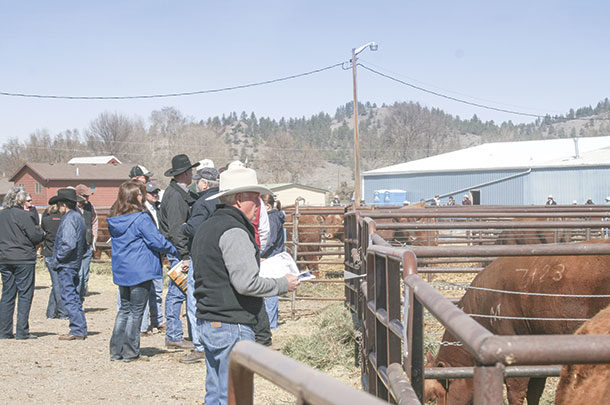Valuing any investment requires determining cost and balancing that against expected returns from that asset – and bulls are no different. It is a lot more complicated than running out and buying the cheapest bull or the most expensive sire in the catalog.
Since so much detail is needed to evaluate bull purchases, it is convenient to work with a decision aid. In evaluating bull purchase prices and the investment in bull tests, a couple of spreadsheet-based decision aids will come in handy. Two useful decision aids when you’re considering a bull purchase can be found at this website (Beef cattle decision aids).
The decision aid we’ll talk about is the “Bull Investment Cost Analysis” spreadsheet. Each decision aid on the linked page has a full description and a downloadable Excel spreadsheet. The numbers in the spreadsheet would be a good place to start and can be replaced with your own numbers or a series of data to look at possibilities.
The bull investment decision aid allows several user inputs and produces tables that compare outcomes by purchase price and cows serviced. Using the decision aid is simple. For example, we will assume a situation based on budgets from a cow-calf producer in the Texas High Plains.
We’ll assume a bull grazing and supplemental feed cost of $575 and a veterinarian and/or medicine cost of $100. These costs include a bull soundness exam and a trichomoniasis test. Both are critically important investments, and in fact, the trichomoniasis test is required in some states. The decision aid automatically assumes our bull will service 25 cows. We’ll assume a bull cost $3,500, a useful life of four years and a salvage value of about $1,260 (1,800 pounds at $70 per hundredweight [cwt]). We’ll assume a weaning rate of 85%, a weaning weight of 530 pounds and a weaned calf price of $150 per cwt. The decision aid produces two tables: annual bull cost at different purchase prices and a sensitivity analysis of cost based on bull costs and cows serviced.
At a purchase price of $3,500, the annual bull service cost per cow is $58.72 per cow, and the annual service cost per cwt weaned is $13.03 per cwt (Table 1).

The different rows show how much cost per cow and cost per cwt weaned change if we choose to spend more or less on our bull. If you believe your bull will bring higher weaning weights, simply change the weaning weight in the spreadsheet. Calves that wean at 600 pounds instead of 530 pounds decrease bull cost per cwt weaned from $13.03 per cwt to $11.51 per cwt.
Now maybe you see a bull for sale that is more expensive but you’re confident it will bring you a higher value per calf weaned. A bull increasing weaning weights is a common example, but you might also base that guess on color or quality of structure. For instance, maybe you see a $4,500 bull that you like whose calves historically bring slightly above-market price.
The decision aid can help you evaluate whether the extra bull expense is a financially sound move. Increasing bull cost from $3,500 to $4,500 means our cost per cwt weaned increases from $13.03 per cwt to $15.70 per cwt. We know that in order for our $4,500 bull to break even when compared with our $3,500 bull, his calves must bring $2.67 per cwt ($0.26 per pound) more.
Table 2 compares the same cost per cow outcome from Table 1 against scenarios where our herd bull services more or less cows.

Using the same assumptions above, our $3,500 bull can cost anywhere from $41.94 per cow to $97.87 per cow annually depending on how many cows serviced.
Now you’re wondering, “OK, you’ve explained just how much a bull will cost, but how do I know whether I’ve spent the correct amount on him?” No worries, we’ll revisit our example. Based on Texas High Plains cow-calf budget, net returns for 2020 are approximately $40.53 per cow, not including the new bull. Including the $58.72 per cow for the bull generates a net loss of $18.19 per cow. Using Table 2 we can find the combination of cows serviced and bull purchase cost to meet our ultimate goal of making a profit.
Certain combinations of bull purchase cost below $3,500 and a number of cows serviced greater than 25 yield a profit. For example, a $2,500 bull that services 30 cows costs $38.94 per cow, yielding a profit in the example of $1.60 per cow.
How much you should spend on a herd bull is complicated and depends on the needs of your herd and your long-term goals. Spending more on a bull that meets your long-term genetic goals might be the appropriate strategy if that bull yields more valuable calves, hopefully leading to higher net returns. We always assume the long-term goal of any cattle enterprise is to make money. So no matter your goals, consider bull cost and returns. ![]()
PHOTO: Using decision aids can be beneficial in making bull purchase decisions based on profitable characteristics and the cost to get them. Photo by Paul Marchant.

-
Justin Benavidez
- Assistant Professor and Extension Economist
- Texas A&M AgriLife Extension Service
- Email Justin Benavidez












